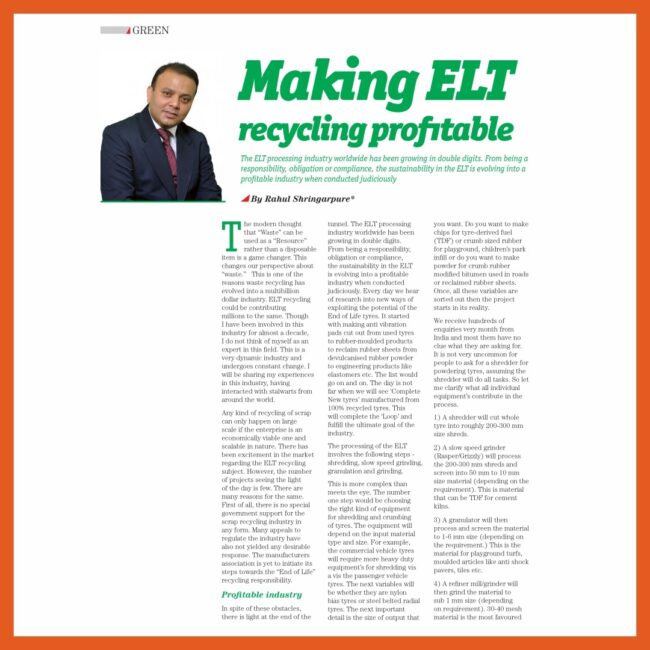Making ELT Recycling Profitable

The ELT processing industry worldwide has been growing in double digits. From being a responsibility, obligation or compliance, the sustainability in the ELT is evolving into a profitable industry when conducted judiciously. He modern thought that “Waste” can be used as a “Resource” rather than a disposable item is a game changer. This changes our perspective about “waste.” This is one of the reasons waste recycling has evolved into a multibillion dollar industry. ELT recycling could be contributing millions to the same. Though I have been involved in this industry for almost a decade, I do not think of myself as an expert in this field. This is a very dynamic industry and undergoes constant change. I will be sharing my experiences in this industry, having interacted with stalwarts from around the world. Any kind of recycling of scrap can only happen on large scale if the enterprise is an economically viable one and scalable in nature. There has been excitement in the market regarding the ELT recycling subject. However, the number of projects seeing the light of the day is few. There are many reasons for the same. First of all, there is no special government support for the scrap recycling industry in any form. Many appeals to regulate the industry have also not yielded any desirable response. The manufacturers association is yet to initiate its steps towards the “End of Life” recycling responsibility.
Profitable industry
- A shredder will cut whole tyre into roughly 200-300 mm size shreds.
- A slow speed grinder (Rasper/Grizzly) will process the 200-300 mm shreds and screen into 50 mm to 10 mm size material (depending on the requirement). This is material that can be TDF for cement kilns.
- A granulator will then process and screen the material to 1-6 mm size (depending on the requirement.) This is the material for playground turfs, moulded articles like anti shock pavers, tiles etc.
- A refiner mill/grinder will then grind the material to sub 1 mm size (depending on requirement). 30-40 mesh material is the most favoured in the Indian subcontinent. This material in used for making, reclaimed rubber sheets, crumb rubber modified bitumen etc.
Any kind of ELT recycling will broadly go through these processes. And of course, there will be many other supporting equipment’s for material conveying, Steel separation, Fiber Separation, Dust &Fiber collection, Size screeners and packing machines.
Fine balance
The best system is the fine balance of all the equipment’s working in tandem. It is believed that every project should be the outcome of fine- tuned solution for every client. All clients are different with respect to their Raw material in feed, output product required, Quantity, Quality required, etc. So a ‘packaged standard plant’ idea would not be the best solution. It would be advisable to have a more customized solution. This solution needs to be cost effective and efficient. The solution can be a blend of high tech main equipment’s being imported from world leading American or European companies and the rest of the equipment’s being manufactured or sourced locally. This can result in a cost saving of about 30 -35% at the least on the overall project. The main equipment’s supplying company can design the specifications to make sourcing more effective. This formula is required to find viabilities in ELT recycling in countries like India where there is no organized collection of ELT. There are no tipping fees and the costs hover around $150 per mt. The cost of land, shed construction and capital are higher here than in the developed world increasing the project cost.
Having said this, sourcing equipments locally is not as easy task. Many Indian vendors are plagued with bad work manshi and are used to not keeping timelines. Their comprehension of requirements is also hampered by their inadequate communication skills. There are high quality vendors too. Their numbers are smaller and thus in high demand resulting in long lead times. Like all other industries, this industry will also develop its own vendors who will update their quality and technology to make projects more cost effective over the period of time. The tyre recycling process has been evolving over the last 60 years in the developed world. There has been thousands of equipment’s installed across the continents. The wear and tear involved in the ELT recycling process is immense. The developed world in ELT recycling has today reached where we want to be. When sourcing equipment’s, one should focus on proven equipments from long standing companies capable of technically supporting you in the long run.
Caution is advised against buying cheaper copies of successful equipment’s made in the Asian subcontinent. Kindly ascertain their efficiencies and durability’s in the real world. The processing capacities claimed have should also be substantiated. There is a lot to write and learn from this dynamic and evolving industry in the context of the Indian subcontinent. I would advise starting small and then scaling up later. Ensure the consistent availability of good quality ELT for processing and the final products as wanted by end buyers. In the meanwhile, we can all as stakeholders push the government towards formulating new reforms regulating the collection and disposal of ELT. The tyre manufacturers association can initiate its responsibility for effective and safe disposal of this resource. An advisory team can also be constituted to help new entrants in the industry regarding the various options available. All this steps and more can help making the recycling of ELT a profitable enterprise and open the doors for more organised players to get involved in the same and taking the industry forward.
– Rahul Shringarpure
